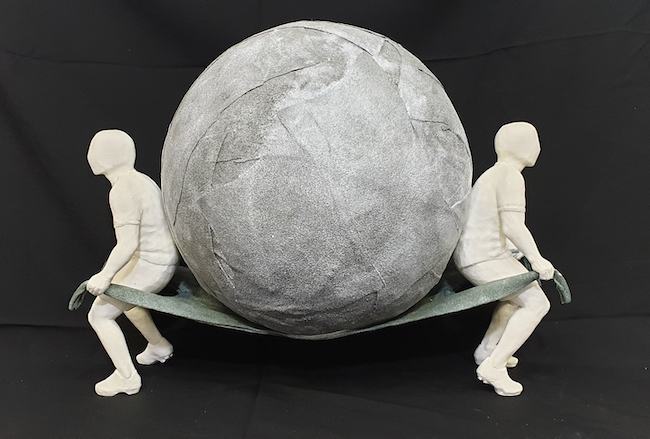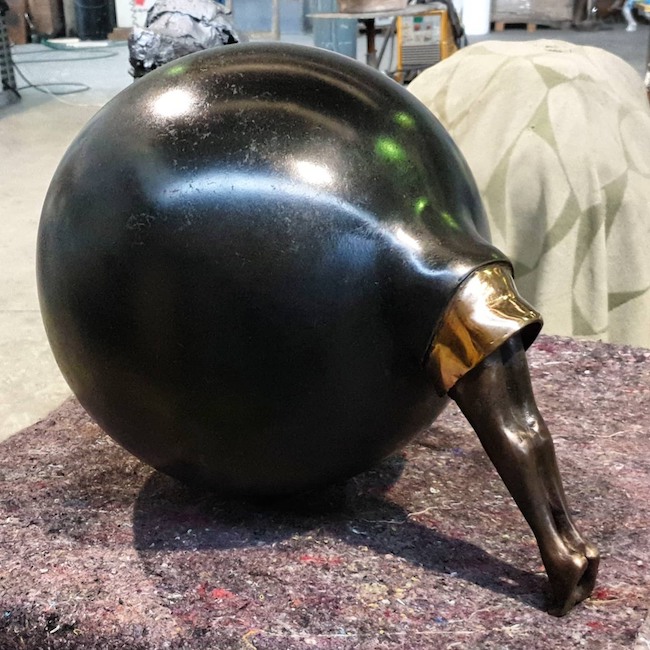L’arte contemporanea sembra essere un contenitore dentro al quale si trovano interpretazioni, punti di vista ma anche sfaccettature caratteriali degli autori di opere pittoriche o scultoree, ognuno dei quali lascia una personale e individuale impronta espressiva in grado di svelare emozioni e sensazioni spesso capaci di coinvolgere l’osservatore trascinandolo nel mondo interiore dell’artista stesso. Nel caso del protagonista di oggi la scultura diviene il mezzo per svelare un approccio dissacrante ma anche divertito sulle stranezze e le difficoltà del vivere contemporaneo.
La scultura moderna ha segnato una spaccatura dalle regole classiche in cui l’estetica e la bellezza dovevano necessariamente emergere per donare ai personaggi o alle scene immortalate quella maestosità e fascino imprescindibile da lavori in grado di interagire con il mondo esterno, di sorprendere il pubblico che si aggirava intorno a esse per ammirarne dettagli e particolari minuziosamente eseguiti; a partire dagli inizi del Novecento invece, pur seguendo la corrente di cambiamento che aveva investito l’intero mondo dell’arte, fu la scultura la manifestazione espressiva che più di tutte lasciò spazio all’individualismo, al singolo sentire dei suoi rappresentanti legandosi solo marginalmente a una corrente specifica e facendo così sentire in modo forte e chiaro voci soliste di grande spessore e intensità. Già verso la fine del Diciannovesimo secolo Auguste Rodin fece proprie le linee guida dell’Espressionismo per infondere alle sue sculture non solo il senso del movimento, differente dunque dai canoni Classici e Barocchi in cui le figure erano riprese in posa perfetta e impeccabile, ma anche descrivendone le sensazioni più profonde, le emozioni interiori, quel sentire che non può non toccare l’osservatore e che non poté non scandalizzare il mondo dell’arte dell’epoca ancora troppo legato alle regole accademiche per comprendere il suo spirito innovativo. Pochi anni dopo emerse un altro grande scultore, Alberto Giacometti le cui opere sottolineavano le sensazioni dell’uomo e il suo senso di disorientamento nel vivere, che si avvicinò inizialmente al Surrealismo per poi spostarsi e generare un vero e proprio Esistenzialismo scultoreo attraverso cui faceva emergere le inquietudini e le incertezze che avvolsero il periodo post bellico; allo stesso modo Max Ernst, decisamente surrealista ma vicino all’ironia sarcastica del Dadaismo, diede vita a opere stilizzate, ispirandosi alle maschere tribali africane, in virtù delle quali racconta un mondo semplificato ma sempre irreale, in cui la linearità e basilarità delle figure rappresenta forse un desiderio di ritornare alla naturalità che invece, in quegli anni, si andava perdendo. La stilizzazione assoluta delle immagini, dei protagonisti sottili e allungati oppure massicci e cubici di Brâncuşi aprì le porte della scultura all’Astrattismo, quell’idealizzazione di forme senza che però a esse fosse tolte la soggettività, il messaggio dell’artista che invece riusciva a infondere incredibile intensità emotiva a sculture come Il bacio.
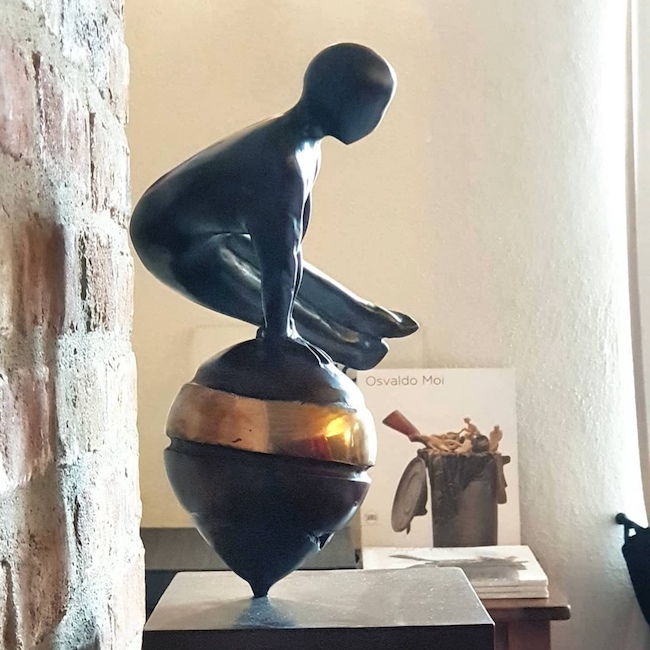
Lo scultore torinese Osvaldo Moi si avvicina al Dadaismo per lo sguardo dissacrante e ironico attraverso il quale osserva il mondo attorno a sé che diviene protagonista di opere bizzarre eppure di forte impatto, in virtù della curiosità, del desiderio di scoprire il mistero che si nasconde nella loro apparenza; è un maestro nell’arte di indurre l’osservatore a porsi domande su ciò che vede, sulle azioni che i personaggi dell’artista stanno compiendo, così come nel descrivere il movimento, quell’andare verso, quel compiere un gesto che in qualche modo si riallaccia all’intento espressivo del Futurismo in cui ciò che doveva emergere da ciascun’opera era il senso dell’agire, dell’essere in progressione verso qualcosa o verso un luogo.
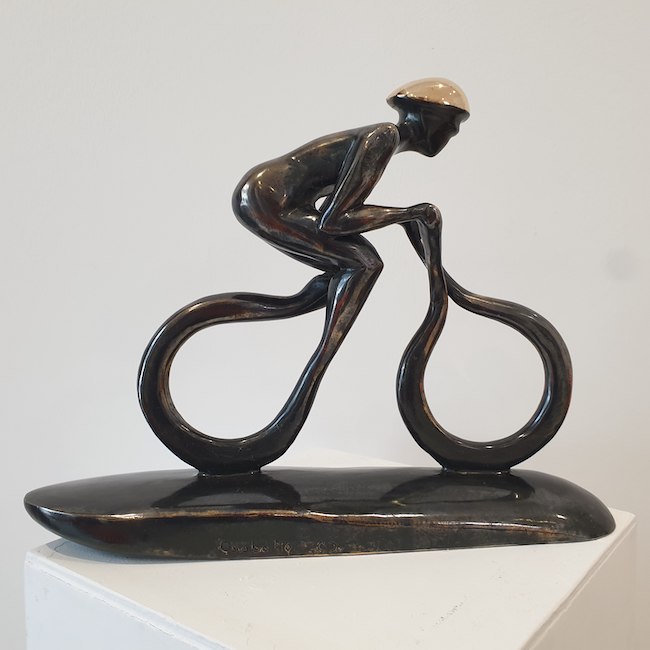
L’approccio alla scultura di Moi è moderno, stilizzato, distante dalla perfezione Classica eppure assolutamente coinvolgente nella totalità dell’immagine dentro cui lo sguardo si perde a cercare il senso, a spiegarne l’enigma, o a comprendere l’inganno ottico sul quale l’autore costringe a soffermarsi e che suggerisce attraverso il titolo.
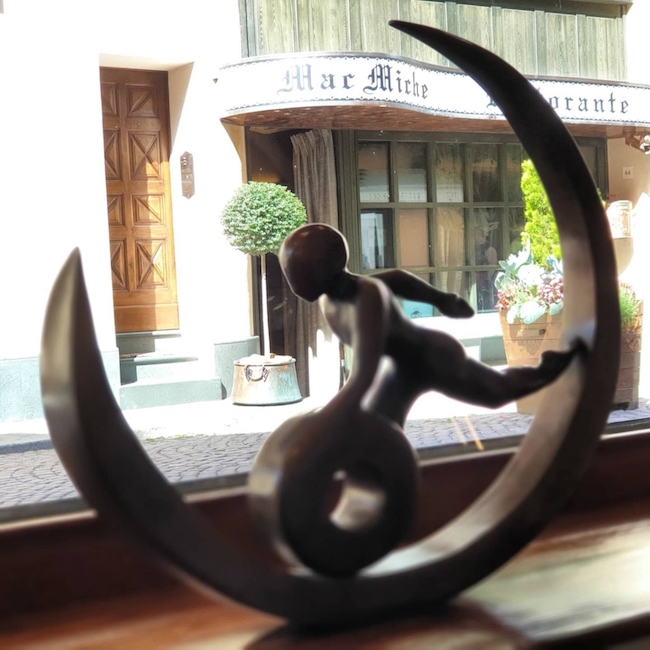
Nell’opera Dalla ruota alla luna, il protagonista appare affannato a correre dietro qualcosa, che può essere un suo desiderio, un suo obiettivo, un impegno oppure, in maniera più metaforica, insegue il sogno che sembra continuare a sfuggirgli; forse è proprio questa la luna menzionata nel titolo, una chimera irraggiungibile che si allontana man mano che l’uomo si avvicina. In qualche modo l’artista gioca con il senso dell’evoluzione, quel credere di aver fatto passi da gigante quando in realtà i bisogni primari, gli istinti, l’innata tendenza a volere di più, siano gli stessi dei nostri avi, in virtù dei quali siamo al punto in cui ci troviamo oggi pronti a inseguire tutto ciò che ancora non è stato ottenuto.
Nella scultura Bimba curiosa, Moi si sofferma sul medesimo tema, quel sentire la necessita di inseguire il mistero, di esplorare l’inconosciuto a volte in maniera persino eccessiva, rischiando di scomparire dentro la propria stessa curiosità che può sconfinare nell’invadente indiscrezione raccontata dall’artista; la protagonista è completamente immersa nella sfera, guidata dal suo irresistibile impulso ad andare oltre il lecito, a conquistare un terreno ignoto senza quasi preoccuparsi delle conseguenze del suo gesto, apparentemente ingenuo ma fondamentalmente metaforico della natura dell’essere umano, quel porsi dei limiti per poi sentire il bisogno di oltrepassarli sfidando le regole.
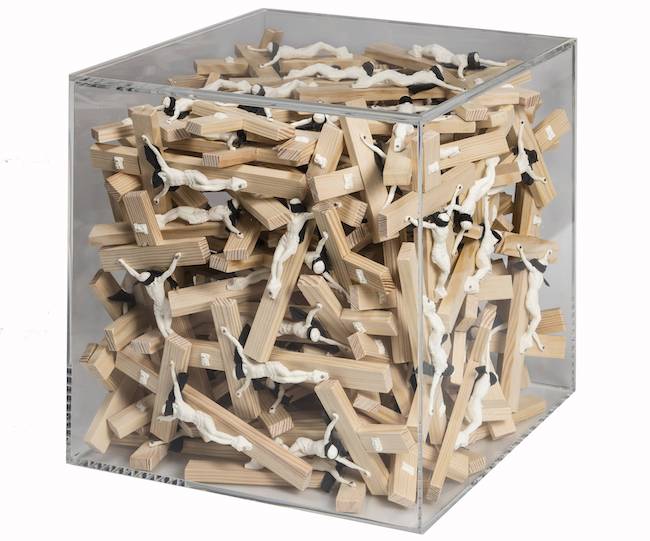
E sono proprio le regole religiose quelle che Osvaldo Moi decide di sfidare con l’opera Crocifissi, quel timore della punizione morale che è insito in qualsiasi forma di credo spirituale, sebbene in questo caso specifico prenda in esame quello cristiano cattolico, da cui decide di affrancarsi ponendo il simbolo della crocifissione di Gesù moltiplicato in numero infinitesimale all’interno di una teca trasparente e di forma cubica. L’intenzione dell’artista è quella di suggerire all’osservatore un punto di vista differente, quello secondo il quale le regole civili vengono definite dall’etica che non necessariamente è legata alla religione anzi, l’auspicio è che si possa costruire una società in cui non sia necessaria la minaccia della punizione per indurre le persone a essere solidali, generose ed empatiche le une con le altre. La vena ironica di Moi è sempre presente, si dispiega attraverso opere divertenti ma anche in grado di indurre l’osservatore a riflettere, a meditare sul significato esistente che va oltre l’immagine inziale, la supera e la arricchisce in modo inimmaginabile a un primo e superficiale sguardo.
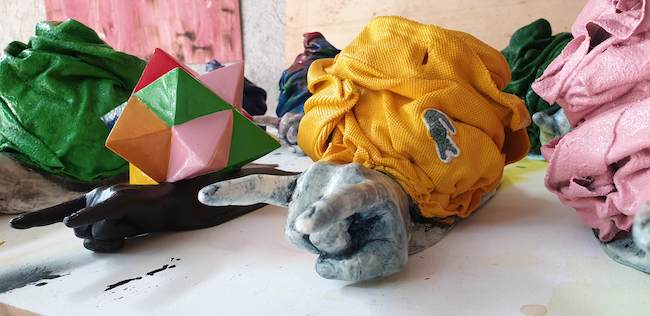
La serie di piccole sculture Escargot (Lumache) sono anch’esse una metafora dell’uomo contemporaneo, rappresentanti una lentezza esistenziale malgrado l’apparato Pop che portano sul dorso del guscio protettivo, quei simboli rassicuranti e di appartenenza a una moda, a un apparire che rassicura la debolezza dell’essere; le mani si sostituiscono al corpo della lumaca e il dito mignolo e l’indice vanno a formare le sue corna, simboleggiando la tendenza tutta italiana ad affidarsi al fato, al credere nella fortuna come se su di essa possa basarsi l’intera esistenza escludendo la capacità di lavorare per ottenere un risultato. Oppure, viste da un’altra angolazione, le opere possono apparire come una rappresentazione grottesca di chi crede fermamente che le parole o gli sguardi degli altri possano in qualche modo incidere, interagire e modificare il corso della vita del singolo, delle sue conquiste, dei suoi risultati; l’invidia, uno dei sette peccati capitali, sembra essere la protagonista assoluta che, secondo la credenza popolare, si combatte rispondendo facendo il gesto scaramantico che l’artista evoca in modo molto chiaro.
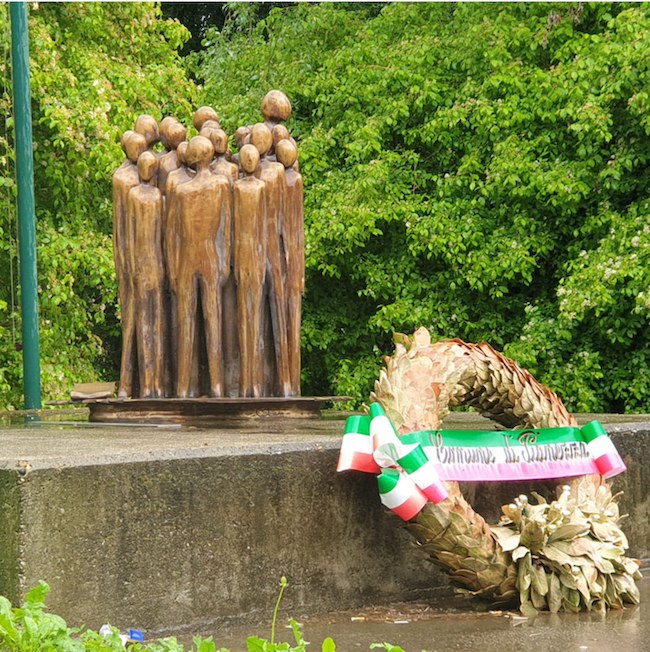
Bronzo, pietra, legno, sono i materiali utilizzati da Osvaldo Moi, che ha donato ai Comuni di Pienezza, in provincia di Torino e Novara tre sculture dedicate ai Caduti di Nassiriya ed esposte in parchi e piazze pubbliche.
OSVALDO MOI-CONTATTI
Email: moi@osvaldomoi.it
Sito web: https://www.osvaldomoi.it
Facebook: https://www.facebook.com/osvaldo.moi
The ironic and bizarre world of Osvaldo Moi’s sculptures
Contemporary art seems to be a container within which we find interpretations, points of view but also facets of the personality of the authors of paintings or sculptures, each of which leaves a distinctive and individual expressive imprint capable of revealing emotions and sensations often able to involve the observer, drawing him into the inner world of the artist himself. In the case of today’s protagonist, sculpture becomes the means of revealing a desecrating but also amused approach to the oddities and difficulties of contemporary life.
Modern sculpture marked a break with the classical rules in which aesthetics and beauty had to necessarily emerge in order to give the characters or scenes immortalised that majesty and fascination inseparable from artworks capable of interacting with the outside world, of surprising the public who wandered around them to admire details and minutely executed details; from the beginning of the 20th century, on the other hand, while following the current of change that had swept through the entire art world, sculpture was the expressive manifestation that most of all left room for individualism, for the individual feelings of its representatives, binding itself only marginally to a specific current and thus making solo voices of great depth and intensity be heard loud and clear. As early as the end of the 19th century, Auguste Rodin adopted the guidelines of Expressionism to imbue his sculptures not only with a sense of movement, thus differing from the Classical and Baroque canons in which the figures were portrayed in perfect, impeccable poses, but also describing their deepest feelings, their inner emotions, that feeling which cannot fail to touch the observer and which could not fail to scandalise the art world of the time, still too tied to academic rules to understand his innovative spirit.
A few years later another great sculptor emerged, Alberto Giacometti, whose works emphasised man’s sensations and his sense of disorientation in living, who initially approached Surrealism before moving on to generate a genuine sculptural Existentialism through which he brought out the anxieties and uncertainties that enveloped the post-war period; similarly Max Ernst, who was decidedly surrealist but close to the sarcastic irony of Dadaism, created stylised artworks, inspired by African tribal masks, by virtue of which he narrates a simplified but always unreal world, in which the linearity and basilarity of the figures perhaps represents a desire to return to the naturalness that was being lost in those years. The absolute stylisation of the images, of Brâncuşi’s slender and elongated or massive and cubic protagonists, opened the doors of sculpture to Abstractionism, that idealisation of forms without, however, taking away their subjectivity, the message of the artist who instead succeeded in infusing sculptures such as The Kiss with incredible emotional intensity. The Turinese sculptor Osvaldo Moi approached Dadaism through the desecrating and ironic gaze through which he observed the world around him, which became the protagonist of bizarre yet powerful artworks, due to his curiosity and desire to discover the mystery hidden in their appearance; he is a master in the art of inducing the observer to ask questions about what he is seeing, about the actions that the artist’s characters are carrying out, as well as in describing movement, that going towards, that making a gesture that in some ways links back to the expressive intent of Futurism in which what had to emerge from each work was the sense of acting, of being in progression towards something or towards a place. Moi’s approach to sculpture is modern, stylised, distant from Classical perfection and yet absolutely enthralling in the totality of the image within which the eye is lost in search of meaning, to explain the enigma, or to understand the optical deception on which the author forces us to dwell and which he suggests through the title. In Dalla ruota alla luna (From the Wheel to the Moon), the protagonist appears to be running after something, which may be a desire, an objective, a commitment or, more metaphorically, chasing the dream that seems to keep eluding him; perhaps this is the moon mentioned in the title, an unattainable chimera that recedes as man approaches.
In some way the artist plays with the sense of evolution, that belief that we have made giant steps forward when in reality the primary needs, the instincts, the innate tendency to want more, are the same as those of our ancestors, by virtue of which we are at the point where we are today ready to pursue everything that has not yet been achieved. In the sculpture Bambina curiosa (Curious little girl), Moi dwells on the same theme, that of feeling the need to pursue the mysterious, to explore the unknown, sometimes even excessively, at the risk of disappearing into one’s own curiosity, which can border on the intrusive indiscretion described by the artist; The protagonist is completely immersed in the sphere, guided by her irresistible impulse to go beyond what is permissible, to conquer unknown territory without almost worrying about the consequences of her gesture, apparently naive but fundamentally metaphorical of the nature of the human being, that of setting limits and then feeling the need to go beyond them by challenging the rules. And it is precisely religious rules that Osvaldo Moi decides to challenge with the work Crocifissi (Crucifixes), that fear of moral punishment that is inherent in any form of spiritual belief, although in this specific case he is examining the Christian Catholic one, from which he decides to free himself by placing the symbol of the crucifixion of Jesus multiplied in infinitesimal numbers inside a transparent, cubic-shaped shrine. The artist’s intention is to suggest a different point of view to the observer, one according to which civil rules are defined by ethics, which are not necessarily linked to religion. On the contrary, the hope is that we can build a society in which the threat of punishment is not necessary to induce people to be supportive, generous and empathetic towards one another. Moi’s ironic vein is always present, unfolding in works that are amusing but also able to induce the observer to reflect, to meditate on the existing meaning that goes beyond the initial image, surpassing it and enriching it in a way that is unimaginable at a first, superficial glance.
The series of small Escargot sculptures are also a metaphor for contemporary man, representing an existential slowness despite the Pop apparatus they carry on their backs, those reassuring symbols of belonging to a fashion, to an appearance that reassures the weakness of being; the hands take the place of the snail’s body and the little finger and index finger form its horns, symbolising the all-Italian tendency to rely on fate, to believe in luck as if the whole of existence could be based on it, to the exclusion of the ability to work for a result. Or, seen from another angle, the artworks may appear to be a grotesque representation of those who firmly believe that the words or glances of others can in some way affect, interact with and modify the course of the individual’s life, his achievements, his results; envy, one of the seven deadly sins, seems to be the absolute protagonist which, according to popular belief, is fought by responding, by making the superstitious gesture that the artist evokes so clearly. Bronze, stone and wood are the materials used by Osvaldo Moi, who has donated three sculptures to the municipalities of Pienezza, in the province of Turin and Novara, dedicated to the Fallen of Nassiriya and exhibited in parks and public squares.


